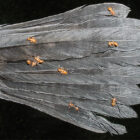What Is Lorikeet Paralysis Syndrome?

Lorikeet Paralysis Syndrome (LPS) is a mysterious ailment that has been affecting wild rainbow lorikeets (Trichoglossus haematodus) across southeastern Queensland and northeastern New South Wales. The disease primarily manifests as paralysis, rendering the birds unable to fly.
Although LPS has been observed for over a decade, the year 2021 saw an unprecedented surge in cases, prompting scientific investigation and concern.
The Impact of LPS
The year 2021 marked a significant escalation in the number of LPS cases observed, particularly in regions like southeastern Queensland and northeastern New South Wales. This surge in cases not only overwhelmed wildlife care facilities but also raised concerns about the long-term survival of the rainbow lorikeet population. The sheer scale of the crisis demanded urgent attention and collaborative efforts from scientists, veterinarians, and wildlife carers.
The influx of paralysed lorikeets placed a considerable strain on the resources of wildlife care facilities. Veterinarians and wildlife carers found themselves grappling with a high volume of cases that required intensive care and long-term rehabilitation. The sheer number of lorikeets needing treatment and care tested the limits of available facilities, leading to difficult decisions about prioritising treatment and the allocation of resources.
Symptoms and Severity
Lorikeet Paralysis Syndrome (LPS) manifests in a variety of symptoms, ranging from mild to severe, with some birds showing signs of paralysis while others exhibit neurological deficits. The severity of the condition can vary greatly, but the impact on the affected birds is profound.
Paralysis and Neurological Deficits
The hallmark symptom of LPS is paralysis, which can affect the bird’s ability to fly, walk, or even stand. This paralysis is often accompanied by neurological deficits, such as difficulty blinking, loss of coordination, and impaired motor skills. The birds may appear disoriented or unsteady on their feet, and they may struggle to maintain their balance.
Breathing and Swallowing Difficulties
In more severe cases, lorikeets with LPS may experience difficulty breathing and swallowing. This can lead to a range of respiratory and digestive issues, including labored breathing, coughing, and regurgitation. The birds may also exhibit signs of distress, such as panting or gasping for air.
Weight Loss and Dehydration
The inability to eat and drink normally can lead to weight loss and dehydration, further exacerbating the bird’s condition. As the bird becomes weaker and more debilitated, it may become more susceptible to predation and other environmental dangers.
Impact on Quality of Life
The symptoms of LPS can have a significant impact on the affected birds’ quality of life. They may become increasingly distressed and agitated as their condition worsens, and they may struggle to perform even the most basic tasks, such as grooming and preening. In severe cases, the birds may become completely immobile, unable to move or feed themselves.
What is causing Lorikeet Paralysis Syndrome?
Despite years of research, the cause of Lorikeet Paralysis Syndrome (LPS) remains elusive. Scientists have ruled out infectious diseases and chemicals like pesticides as potential causes. Instead, they are exploring the possibility that a toxin, possibly a bacteria or fungi, is responsible. This theory aligns with the seasonal nature of the disease, which peaks during the warmer months when plants are actively growing.
The Role of Plants
Plants play a central role in the investigation into LPS. Rainbow lorikeets are known to feed on a variety of plant species, including Eucalypts, Bottlebrush, Grevillea, Banksia, and Coral tree, among others. This diverse diet makes it challenging to identify which specific plant or plants may be the source of the toxin. Researchers are conducting extensive analyses of the plants in the lorikeets’ environment, looking for any potential toxins or pathogens.
The Challenge of Identification
Identifying the specific toxin responsible for LPS is a complex task. One approach is to analyze the birds’ organs, droppings, and gut contents for any traces of the toxin. Additionally, researchers are conducting necropsies to study the birds’ tissues and organs for any signs of damage or abnormality. Toxicology tests are also being performed to identify any chemicals or substances that may be present.
The Mystery Deepens
Despite these efforts, the mystery of LPS persists. The challenge of identifying the toxin is compounded by the fact that rainbow lorikeets have been observed feeding on a wide variety of plant species. This diversity makes it difficult to pinpoint which plant or plants may be the source of the toxin. Nevertheless, researchers remain committed to finding answers and are exploring every avenue to unravel the mystery of LPS.










